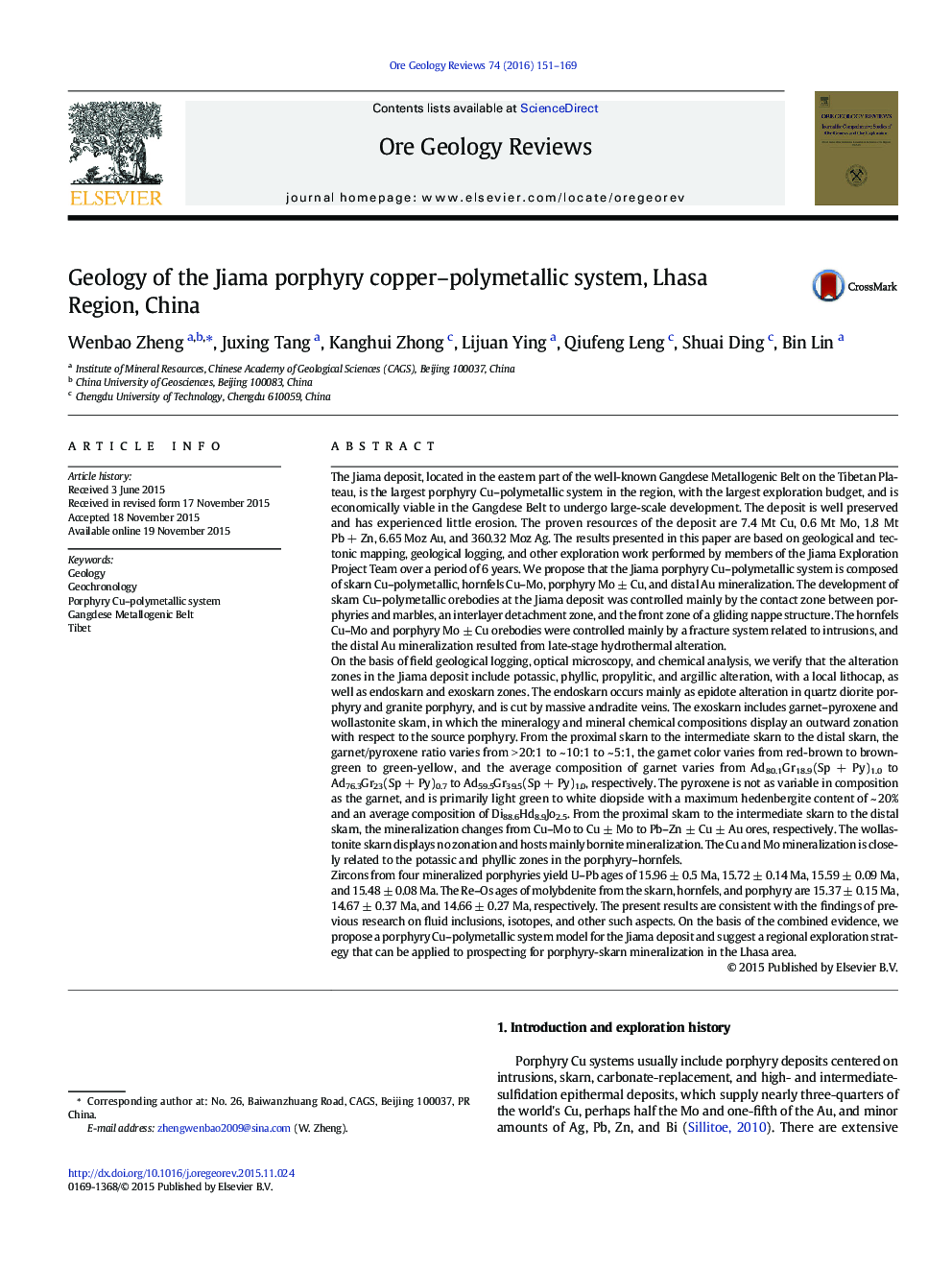| کد مقاله | کد نشریه | سال انتشار | مقاله انگلیسی | نسخه تمام متن |
|---|---|---|---|---|
| 4696830 | 1637232 | 2016 | 19 صفحه PDF | دانلود رایگان |
• The Jiama deposit is the largest porphyry Cu-polymetallic system in China, by now.
• The Jiama deposit is controlled by the strata combination, interlayer detachment zone and porphyry emplacement.
• The diagenesis and mineralization ages of the deposit are the Miocene (16–14 Ma).
The Jiama deposit, located in the eastern part of the well-known Gangdese Metallogenic Belt on the Tibetan Plateau, is the largest porphyry Cu–polymetallic system in the region, with the largest exploration budget, and is economically viable in the Gangdese Belt to undergo large-scale development. The deposit is well preserved and has experienced little erosion. The proven resources of the deposit are 7.4 Mt Cu, 0.6 Mt Mo, 1.8 Mt Pb + Zn, 6.65 Moz Au, and 360.32 Moz Ag. The results presented in this paper are based on geological and tectonic mapping, geological logging, and other exploration work performed by members of the Jiama Exploration Project Team over a period of 6 years. We propose that the Jiama porphyry Cu–polymetallic system is composed of skarn Cu–polymetallic, hornfels Cu–Mo, porphyry Mo ± Cu, and distal Au mineralization. The development of skarn Cu–polymetallic orebodies at the Jiama deposit was controlled mainly by the contact zone between porphyries and marbles, an interlayer detachment zone, and the front zone of a gliding nappe structure. The hornfels Cu–Mo and porphyry Mo ± Cu orebodies were controlled mainly by a fracture system related to intrusions, and the distal Au mineralization resulted from late-stage hydrothermal alteration.On the basis of field geological logging, optical microscopy, and chemical analysis, we verify that the alteration zones in the Jiama deposit include potassic, phyllic, propylitic, and argillic alteration, with a local lithocap, as well as endoskarn and exoskarn zones. The endoskarn occurs mainly as epidote alteration in quartz diorite porphyry and granite porphyry, and is cut by massive andradite veins. The exoskarn includes garnet–pyroxene and wollastonite skarn, in which the mineralogy and mineral chemical compositions display an outward zonation with respect to the source porphyry. From the proximal skarn to the intermediate skarn to the distal skarn, the garnet/pyroxene ratio varies from > 20:1 to ~ 10:1 to ~ 5:1, the garnet color varies from red-brown to brown-green to green-yellow, and the average composition of garnet varies from Ad80.1Gr18.9(Sp + Py)1.0 to Ad76.3Gr23(Sp + Py)0.7 to Ad59.5Gr39.5(Sp + Py)1.0, respectively. The pyroxene is not as variable in composition as the garnet, and is primarily light green to white diopside with a maximum hedenbergite content of ~ 20% and an average composition of Di88.6Hd8.9Jo2.5. From the proximal skarn to the intermediate skarn to the distal skarn, the mineralization changes from Cu–Mo to Cu ± Mo to Pb–Zn ± Cu ± Au ores, respectively. The wollastonite skarn displays no zonation and hosts mainly bornite mineralization. The Cu and Mo mineralization is closely related to the potassic and phyllic zones in the porphyry–hornfels.Zircons from four mineralized porphyries yield U–Pb ages of 15.96 ± 0.5 Ma, 15.72 ± 0.14 Ma, 15.59 ± 0.09 Ma, and 15.48 ± 0.08 Ma. The Re–Os ages of molybdenite from the skarn, hornfels, and porphyry are 15.37 ± 0.15 Ma, 14.67 ± 0.37 Ma, and 14.66 ± 0.27 Ma, respectively. The present results are consistent with the findings of previous research on fluid inclusions, isotopes, and other such aspects. On the basis of the combined evidence, we propose a porphyry Cu–polymetallic system model for the Jiama deposit and suggest a regional exploration strategy that can be applied to prospecting for porphyry-skarn mineralization in the Lhasa area.
Figure optionsDownload as PowerPoint slide
Journal: Ore Geology Reviews - Volume 74, April 2016, Pages 151–169
